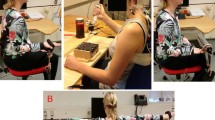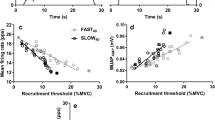Abstract
The study aimed to characterize trapezius motor unit firing pattern in low-amplitude contractions, with emphasis on respiratory modulated activity. Constant-amplitude contractions with shoulder elevation, controlled by feedback of the root mean square detected surface electromyographic (SEMG) signal, typing with arm movement and tasks with mental stress were performed. Single motor unit activity was recorded by a quadrifilar fine-wire electrode. A surface electrode simultaneously recorded SEMG activity. Contraction amplitudes ranged from 1 to 10% of the SEMG signal at maximum voluntary contraction (1–10% EMGmax). The majority (∼80%) of motor units recorded during constant-amplitude contractions showed firing rate modulation at the respiratory frequency. Respiratory firing rate modulation was clear for low amplitude contractions (< 3% EMGmax), but was reduced at higher amplitudes (3–5.9% EMGmax). Most motor units had peak firing rate at the transition from inspiration to expiration, but peak firing rate at the transition from expiration to inspiration or at the first harmonic frequency was also observed. The SEMG signal showed little or no respiratory modulation, possibly because respiratory phase varied between motor units. Respiratory modulation of firing rates was significantly reduced in experiments with mental stress and was rarely observed in typing experiments. Both central respiratory drive and peripheral afferent input may contribute to respiratory modulation of firing rates; however, animal studies indicate a central source of the respiratory modulated input. We speculate that the reduction in respiratory modulation of motor activity with mental stress is due to activation of alternative pathways providing excitatory input to trapezius motoneurons.







Similar content being viewed by others
References
Aston-Jones G, Bloom FE (1981) Norepinephrine-containing locus coeruleus neurons in behaving rats exhibit pronounced responses to non-noxious environmental stimuli. J Neurosci 1:887–900
Bansevicius D, Westgaard RH, Jensen C (1997) Mental stress of long duration: EMG activity, perceived tension, fatigue, and pain development in pain-free subjects. Headache 37:499–510
Basmajian JV, De Luca CJ (1985) Muscles alive. Williams & Wilkins, Baltimore
Bonato P, Ceravolo R, De Stefano S, Molinari F (2000) Use of cross-time–frequency estimators for the structural identification in non-stationary conditions and under unknown excitation. J Sound Vib 237:775–791
Bonato P, Westad C, Westgaard R H (2003) Time–frequency analysis of motor unit recordings to characterize rhythmic behavior in activity pattern of trapezius muscle. 47–50, Capri (Italy). 1st international IEEE EMBS conference on neural engineering, March 20–22
Campbell EJM (1968) The respiratory muscles. Ann NY Acad Sci 155:135–139
Carrasco GA, Van de Kar LD (2003) Neuroendocrine pharmacology of stress. Eur J Pharmacol 463:235–272
Cohen L (1995) Time–frequency analysis. Prentice-Hall, Englewood Cliffs
De Luca CJ, Adam A (1999) Decomposition and analysis of intramuscular electromyographic signals. In: Windhorst U, Johansson H (eds) Modern techniques in neuroscience research. Springer, Berlin Heidelberg New York, pp 757–776
De Luca CJ, Erim Z (1994) Common drive of motor units in regulation of muscle force. Trends Neurosci 17:299–305
De Luca CJ, LeFever RS, McCue MP, Xenakis AP (1982) Control scheme governing concurrently active human motor units during voluntary contractions. J Physiol 329:129–142
Heckman CJ, Gorassini M, Bennett DJ (2005) Persistent inward currents in motoneuron dendrites: implications for motor output. Muscle Nerve 31:135–156
Holte KA, Westgaard RH (2002) Further studies of shoulder and neck pain and exposures in customer service work with low biomechanical demands. Ergonomics 45:887–909
Hwang J-C, Bartlett D, St.John WM (1983) Characterization of respiratory-modulated activities of hypoglossal motoneurons. J Appl Physiol 55:793–798
Jacobs BL (1986) Single unit activity of locus coeruleus neurons in behaving animals. Prog Neurobiol 27:183–194
Jacobs BL, Abercrombie ED, Fornal CA, Levine ES, Morilak DA, Stafford IL (1991) Single-unit and physiological analyses of brain norepinephrine function in behaving animals. Prog Brain Res 88:159–165
Jensen C, Vasseljen O, Westgaard RH (1993) The influence of electrode position on bipolar surface electromyogram recordings of the upper trapezius muscle. Eur J Appl Physiol 67:266–273
Jensen C, Borg V, Finsen L, Hansen K, Juul-Kristensen B (1998) Job demands, muscle activity and musculoskeletal symptoms in relation to work with the computer mouse. Scand J Work Environ Health 24:418–424
Kierner AC, Zelenka I, Burian M (2001) How do the cervical plexus and the spinal accessory nerve contribute to the innervation of the trapezius muscle? Arch Otolaryngol Head Neck Surg 127:1230–1232
Kierner AC, Burian M, Bentzien S, Gstoettner W (2002) Intraoperative electromyography for identification of the trapezius muscle innervation: clinical proof of a new anatomical concept. Laryngoscope 112:1853–1856
Kirkwood PA, Lawton M, Ford TW (2002) Plateau potentials in hindlimb motoneurones of female cats under anaesthesia. Exp Brain Res 146:399–403
Laursen B, Jensen BR, Németh G, Sjøgaard G (1998) A model predicting individual shoulder muscle forces based on relationship between electromyographic and 3D external forces in static position. J Biomech 31:731–739
LeFever RS, De Luca CJ (1982) A procedure for decomposing the myoelectric signal into its constituent action potentials—part 1 technique, theory and implementation. IEEE Trans Biomed Eng 29:149–157
Mambrito B, De Luca CJ (1984) A technique for the detection, decomposition and analysis of the EMG signal. Electroencephalogr Clin Neurophysiol 58:175–188
Marple SL (1987) Digital spectral analysis. Prentice-Hall, Englewood Cliffs
Meyer-Lohmann J (1974) Respiratory influences upon the lumbar extensor motor system of decerebrated cats. In: Umbach W, Koepchen HP (eds) Central rhythmic and regulation. Hippokrates Verlag, Stuttgart, pp 334–341
Mork PJ, Westgaard RH (2004) The association between nocturnal trapezius muscle activity and shoulder and neck pain. Eur J Appl Physiol 92:18–25
Mork PJ, Westgaard RH (2005) Long-term electromyographic activity in upper trapezius and low back muscles of females with moderate physical activity. J Appl Physiol 99:570–578
Nickolls P, Collins DF, Gorman RB, Burke D, Gandevia SC (2004) Forces consistent with plateau-like behaviour of spinal neurons evoked in patients with spinal cord injuries. Brain 127:660–670
Nilsen KB, Westgaard RH, Stovner LJ, Helde G, Rø M, Sand TH (2006) Pain induced by low-grade stress in patients with fibromyalgia and chronic shoulder/neck pain, relation to surface electromyography. Eur J Pain (in press)
Önal E, Lopata M, O’Connor TD (1981) Diaphragmatic and genioglossal electromyogram responses to CO2 rebreathing in humans. J Appl Physiol 50:1052–1055
Pettersen V, Westgaard RH (2005) The activity patterns of neck muscles in professional classical singing. J Voice 19:238–251
Pettersen V, Bjørkøy K, Torp H, Westgaard RH (2005) Neck and shoulder muscle activity and thorax movement in singing and speaking tasks with variation in vocal loudness and pitch. J Voice 19:623–634
Proakis JG, Manolakis DG (1996) Digital signal processing: principles, algorithms, and applications. Prentice-Hall, Englewood Cliffs
Saboisky JP, Butler JE, Fogel RB, Taylor JL, Trinder JA, White DP, Gandevia SC (2006) Tonic and phasic respiratory drives to human genioglossus motoneurons during breathing. J Neurophysiol 95:2213–2221
Schleifer LM, Ley R, Spalding TW (2002) A hyperventilation theory of job stress and musculoskeletal disorders. Am J Ind Med 41:420–432
Tsuiki S, Ono T, Ishiwata Y, Kuroda T (2000) Functional divergence of human genioglossus motor units with respiratory-related activity. Eur Respir J 15:906–910
Vasseljen O, Westgaard RH (1995) A case-control study of trapezius muscle activity in office and manual workers with shoulder and neck pain and symptom-free controls. Int Arch Occup Environ Health 67:11–18
Vasseljen O, Westgaard RH (1997) Arm and trunk posture during work in relation to shoulder and neck pain and trapezius activity. Clin Biomech 12:22–31
Wærsted M, Westgaard RH (1996) Attention-related muscle activity in different body regions during VDU work with minimal physical activity. Ergonomics 39:661–676
Wærsted M, Bjørklund RA, Westgaard RH (1994) The effect of motivation on shoulder-muscle tension in attention-demanding tasks. Ergonomics 37:363–376
Weiner D, Mitra J, Salamone J, Cherniack NS (1982) Effect of chemical stimuli on nerves supplying upper airway muscles. J Appl Physiol 52:530–536
Westad C, Westgaard RH (2005) The influence of contraction amplitude and firing history on spike-triggered averaged trapezius motor unit potentials. J Physiol 562:965–975
Westad C, Mork PJ, Westgaard RH (2004) Firing patterns of low-threshold trapezius motor units in feedback-controlled contractions and vocational motor activities. Exp Brain Res 158:465–473
Westgaard RH, Bjørklund R (1987) Generation of muscle tension additional to postural muscle load. Ergonomics 30:911–923
Zemlin WR (1997) Speech and hearing science. Anatomy and physiology. Allyn & Bacon, Needham Heights
Acknowledgments
We are grateful to the Office Ergonomics Research Committee (OERC) for financial support of this study. Christian Westad was supported by the Research Council of Norway. Peter Kirkwood of University College London has provided helpful comments for the interpretation of findings.
Author information
Authors and Affiliations
Corresponding author
Rights and permissions
About this article
Cite this article
Westgaard, R.H., Bonato, P. & Westad, C. Respiratory and stress-induced activation of low-threshold motor units in the human trapezius muscle. Exp Brain Res 175, 689–701 (2006). https://doi.org/10.1007/s00221-006-0587-3
Received:
Accepted:
Published:
Issue Date:
DOI: https://doi.org/10.1007/s00221-006-0587-3




